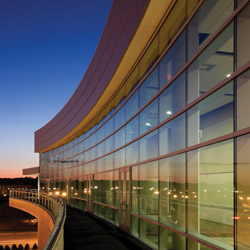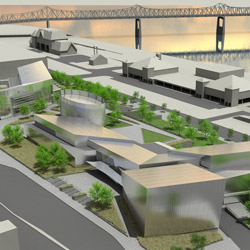Our Stage to the World

Persistence is paying off in Peoria. Thanks to years of careful planning, a commitment to collaboration and a creative, forward-thinking approach, the community will soon benefit from several prominent building projects that will help reshape our urban profile as a world-class center of culture, business and education.
Following the release of a highly favorable economic impact study and voter approval of a sales tax increase to provide public funding, the vision of a dynamic downtown is rapidly taking shape. The completion of the museum block, together with the recently completed Peoria Civic Center expansion and the addition of new and improved hotel space, will enhance the city’s stature as a national—and international—destination with a compelling array of attractions.
“Every city has a civic center, hotels, restaurants and the basics needed to host visitors from out of town,” says Brent Lonteen, president and CEO of the Peoria Area Convention and Visitors Bureau. “We have to stand out to compete. This will be a terrific riverfront block that is within walking distance from the Civic Center and the hotels. It will appeal to both locals and visitors from out of town and will make us more attractive to meeting planners. All of these things combined will create buzz about Peoria on a national scale.”
A Civic Amenity
After a detailed planning process and meticulous financial analysis that assessed long-term economic benefits, the Peoria Civic Center Authority completed a major revitalization and expansion project. The $55 million expansion, which included the addition of a new ballroom and extensive exhibit space, has enabled the Civic Center to offer more options and flexibility to convention meeting planners throughout the country.
“The ballroom also serves as meeting space, and that is the component we really needed to expand in order to be more competitive,” says Debbie Ritschel, general manager of the Civic Center. “With the revitalization, we not only added space, we improved the facility in many ways. In addition to the ballroom, we’ve created pre-event space that can host receptions or registration activities. The finishes and furnishings are of a much higher quality now as well. People have been very pleased and impressed.”
Rebekah Bourland, past chair and long-time member of the authority, notes that the recent construction also provided an opportunity to enhance the functionality of the Center. “There was a deliberate, multi-phased approach that included financial assessments, budgeting, focus groups and programming,” she says. “Adding meeting space was important, but we also needed to improve some of the logistical aspects—the loading docks, truck access and so forth. It’s a much more user-friendly facility now.”
Both Ritschel and Bourland point out that the multi-functional design is a unique attribute. “The Civic Center is a convention center, an arena and a theater,” Bourland says. “The Center has more than met its original mission. We’ve helped to create a vibrant downtown. We wanted to generate more activity downtown, and that has proven to be the case.”
“The Civic Center is a full entertainment and meeting complex,” adds Ritschel. “We are one of the largest convention centers outside of the Chicago area, so we provide a cost-effective alternative for many groups. We offer a friendly community and the services to support our event space. As we bring in visitors staying overnight, as well as drive-in, drive-out visitors, we are creating a positive economic impact for our entire community.” Enhancing Peoria’s Competitive Edge
Enhancing Peoria’s Competitive Edge
The completion of “The Block,” a seven-acre downtown property along the Illinois River, is envisioned as a major boost to the city’s appeal to visitors from throughout the state and beyond. The site, which once housed a Sears department store, will be the new home of the Peoria Riverfront Museum and The Caterpillar Experience, an interactive museum and visitor center.
Jim Richerson, president and CEO of the Lakeview Museum of Arts and Sciences, points to the collaborative partnerships driving the development as a critical ingredient in ensuring The Block’s success. “There is a history of collaboration in this community,” Richerson says. “The new Peoria Riverfront Museum and The Caterpillar Experience represent an opportunity to continue that tradition of collaboration. We’re developing a campus together—Caterpillar, Lakeview Museum, Peoria Historical Society, African American Hall of Fame Museum, Illinois High School Association, Peoria Regional Museum Society and the Heartland Foundation. The partnerships take this development concept to a much higher level. I envision that other communities will look at what we’ve done in Peoria and want to know how we achieved this.”
The Peoria Riverfront Museum will appeal to people of all ages, says Richerson. “We are an interdisciplinary museum focused on lifelong learning—we cover art, science, history and achievement. It’s a blended approach that reflects the way we learn. There will be something in the new museum that will touch everyone. We want to inspire people.”
Highlights will include a digital 3-D IMAX Theatre, a state-of-the-art planetarium, an Illinois River gallery, numerous art exhibits, international exhibits, a hands-on children’s discovery area and the Illinois High School Association’s Peak Performance Center. “People will come for one reason but discover a lot of different worlds,” says Richerson. “This will greatly enhance the competitive edge of our community. If we are going to move forward, we need to focus on creativity and innovation. This is a phenomenal opportunity to help keep people in Peoria and to attract new people. We are building our stage to the world.”
Homegrown Stimulus
With the economic boost provided by a more competitive Civic Center—which currently welcomes approximately 900,000 visitors annually—as well as the projected completion of The Block, Peoria is well positioned to temper the severity of the global economic downturn. “Because of the pledged private support for The Block, the positive return on the public investment is very high and extremely rare,” noted Dr. Robert Scott of Bradley University, upon the recent completion of the development’s economic impact study.
The economic team found that over a 20-year period, $14 would be returned to the community in economic activity for every $1 in sales tax, based in part on an estimated $9 million per year in additional commerce through visitor spending.
Following the successful tax referendum, The Block may be completed as soon as mid-2012. The development will be supported in large part by Caterpillar, which is funding the $41 million Caterpillar Experience and has also pledged $13.5 million toward the Peoria Riverfront Museum, a $77 million project. With the sales tax funding and the private funding already pledged, the museum is well on its way to becoming a reality, but additional funding is still critically needed. For more information on how to contribute, visit BuildTheBlock.org.
The community’s investment should prove to be well worth it, according to Scott. “I’ve never seen a local opportunity where the return on public investment is this high. It’s something that happens maybe once in a lifetime.”
“The riverfront block will have year-round impact,” adds Brent Lonteen. “In the summer, there is always a lot going on but this will help with activities throughout the winter. It will be a priceless part of our community. It’s a really exciting time for development in this area.” iBi

